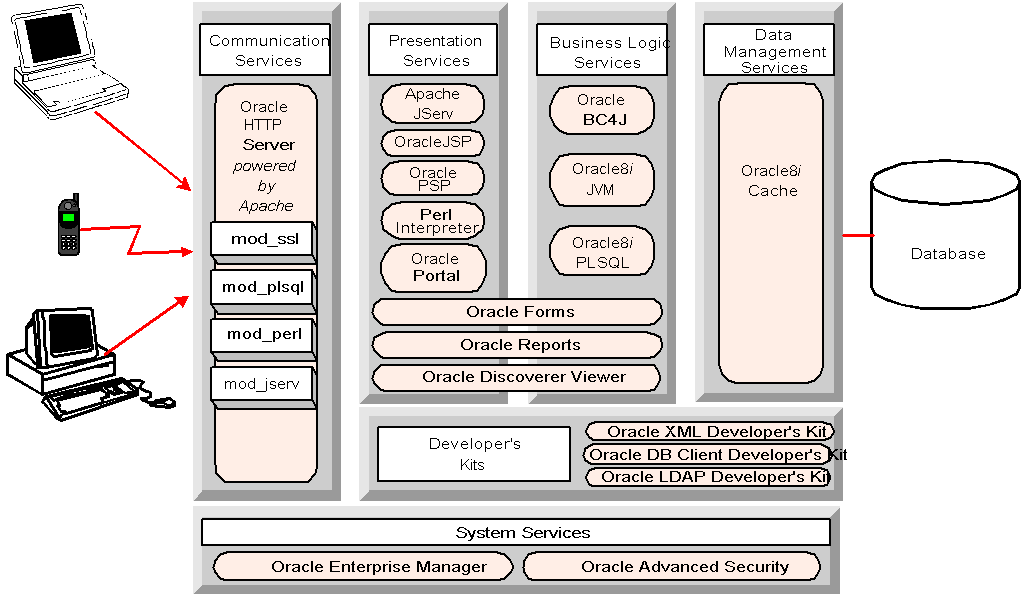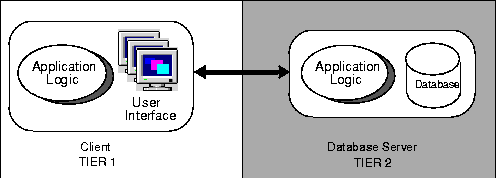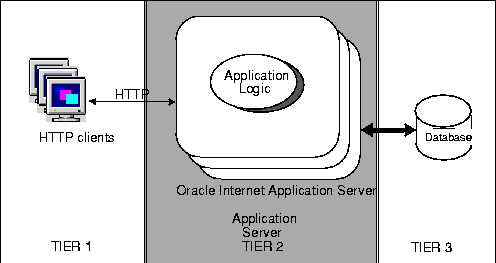Release 1.0.1
A83707-02
Library |
Product |
Contents |
Index |
| Oracle Internet Application Server 8i Overview Guide Release 1.0.1 A83707-02 |
|
This chapter describes Oracle Internet Application Server, how you can use it, and what technologies it supports.
Becoming an e-business is part of being a business success. When you decide to move into the electronic arena, usually the first step taken is to create and host a company Web site. At the beginning, your Web site is a simple collection of static pages that gives your company market exposure on the Internet. As you become more comfortable with maintaining the Web site and more knowledgeable about the marketing and sales potential offered by an Internet presence, you want to offer more than electronic marketing collateral in the form of static Web pages.
Providing your customers with information that is generated dynamically from inventory or catalog data stores is also essential to growing your business. The next step for your enterprise may be to host an online store or a business-to-business exchange. As your e-business grows, you want to offer your customers and employees greater access to products and services on a broad level. Self-service applications can help you increase your productivity and efficiency when dealing with customers and when managing your employees.
Each step in your evolution into a full-fledged e-business produces gains that motivate you to continue building your company's Internet presence. However, as you add more functionality to your company Web site, your Internet infrastructure must support that growth. Ideally, you want an infrastructure that can grow with your business. One that can start small and support your growing number of customers and employees. If you start with the right technology in the beginning, then you will not have to change later when you find your company in a success crisis.
Oracle Internet Platform provides integrated development, deployment, and management tools to simplify creating and deploying the e-business applications that you need to run your business on the Internet. Using Oracle Internet Platform, which consists of Oracle Internet Application Server and Oracle8i, you can:
Oracle Internet Application Server can support all of your transactional applications and business intelligence applications whether they are newly developed Java-based programs or your legacy applications.
Oracle Internet Application Server is seamlessly integrated with Oracle8i so you can manage all of your data including relational data, business documents, or multimedia files. With Oracle8i Cache contained in Oracle Internet Application Server, your users can access your data faster than ever. (For information about Oracle8i Cache, see "Data Management Services".)
Using Oracle Internet Application Server, you can deploy portals, giving your employees and your customers the clarity of a single view of your applications and your information, and the ease of a single signon. Portals give users a consistent look, feel, and navigation to the interface so they can learn quickly and become more productive. Moreover, using portals you can set up self-service content submission, so your Web site requires no maintenance.
Oracle Internet Application Server is a reliable, scalable, secure, middle-tier application server that is designed to support your evolution into an e-business. Using it, you can deliver Web content, host Web applications, process transactions, and make these services accessible to any client browser. Your users can access information, perform business analysis, and run business applications on the Internet, or on internal and external corporate intranets.
You can use Oracle Internet Application Server for:
Oracle Internet Application Server delivers Web content for the Internet and for internal and external intranets in the form of:
Using the proven technology of the Apache Web Server, Oracle Internet Application Server delivers static content such as HTML pages, XML data, and text files. Oracle HTTP Server Web listener delivers static content rapidly to a large user base with high performance, reliability, and stability.
With Oracle HTTP Server modules and the many Apache modules that are included in the HTTP Server component, Oracle Internet Application Server can support all of the current Internet application technologies for delivering dynamic content such as Java servlets, JavaServer Pages, PL/SQL Server Pages, XML, and CGI scripts using Perl.
In addition, Oracle Internet Application Server is tightly integrated with Oracle8i Cache and can call PL/SQL stored procedures through the Oracle HTTP Server PL/SQL module (mod_plsql) that integrates seamlessly with Oracle HTTP Server.
On internal or external corporate intranets, business documents can easily be published. For example, you can publish word-processed documents, spreadsheets, slide presentations, and various documents in Adobe's Portable Document Format (.pdf).
To know what is happening in your e-business every day, you can deploy and share business intelligence over the Web or over your corporate intranet using Oracle Internet Application Server:
Oracle Internet Application Server supports both stateless and stateful transactional Web applications. A stateless application maintains no state information within its environment. However, it may maintain state information in a persistent store such as a database or a browser. For example, a shopping cart program that stores the contents of a user's cart in a cookie in the browser is a stateless application. Every time the user makes a request to the application, the browser sends over both the URL and the cookie. The application itself does not need to keep track of the user's shopping cart between successive client calls. This can be implemented as CGI scripts, stateless Java servlets, or in a variety of other ways.
On the other hand, a stateful application does maintain session state information within its runtime environment between successive client calls. If the shopping cart application, which was used in the above example, is stateful, then the application itself will keep track of the contents of the user's shopping cart instead of sending this information to the client's browser every time. Java servlets, for example, maintain session state by attaching state information to an HttpSession object that is specific to each user session. Every time a user issues a new HTTP request to the server, the server associates the request with the HttpSession object for that user.
For information about transactional application development models, see "Business Logic".
Figure 1-1 lists Oracle Internet Application Server services and elements. For a description of these services and elements, see Chapter 2, "Oracle Internet Application Server Services".

Oracle Internet Application Server consists of a set of services that can be implemented in a distributed environment for scalability and reliability. The following sections provide an architectural overview of Oracle Internet Application Server.
Client/server computing architectures are commonly described as having two or more tiers according to how application logic is distributed between client and server. Minimally, a client/server architecture must have a client tier and a server tier. Oracle's internet computing model is based on a multi-tier computing model in which Oracle Internet Application Server functions as a middle tier, or application server tier.
Traditional database client/server architecture is based on a two-tier computing model. This model consists of a client tier and a database server tier (see Figure 1-2). Processing tasks and application logic are shared between the database server and the client.

Several disadvantages exist for this model. The clients in a two-tier computing model are fat clients, where much of the processing power and application logic reside. This makes the clients costly to maintain. Furthermore, clients can be operating on different platforms, necessitating the deployment of platform-specific versions of applications.
The three-tier computing model evolved to address the problems of the two-tier model. In a three-tier model, a middle tier exists between clients and the database server. This middle tier consists of an application server that contains the bulk of the application logic. Clients in the model are thin clients. With this architecture, application logic resides in a single tier and can be maintained easily at one point. The architectural design of the middle tier is optimized for server functions including access to a database.
Oracle Internet Application Server serves as the middle tier of the three-tier model as shown in Figure 1-3.

In this thin-client three-tier architecture, client software (the client tier) is lightweight enough to be downloaded on demand, and does little but present the user interface for a server-side application. The bulk of the application logic is implemented either in the middle (application server) tier or is stored in the database, as in the case of PL/SQL , Java stored procedures, or Enterprise JavaBeans.
Oracle Internet Application Server enables users to deploy HTTP and HTML-based applications within its multi-tiered architecture. The middle-tier server centrally manages application logic sending request responses back to thin clients, typically Web browsers. A third tier houses your database, so transaction processing on the database may be optimized. This multi-tiered model offers great savings in administration and maintenance costs when deploying applications.
Oracle Internet Application Server components reside on the middle-tier in a three-tier architecture as shown in Figure 1-4.

Alternatively, you may also run the Oracle Internet Application Server in a multi-tiered architecture of four or more tiers, depending on your application needs. For example, it is possible to divide the Report Services across multiple machines. In a four-tier configuration, you should run the Reports Web CGI or the Reports Servlets on the same machine as the HTTP Server and run the Report Server on a separate machine. In this example, the client browser resides in the first tier and your database resides on a fourth-tier.
For more information on this example, see Publishing Reports to the Web with Internet Application Server on your Documentation Library CD-ROM.
Currently, Oracle Internet Application Server is available in two versions: the Standard Edition and the Enterprise Edition. The Standard Edition is suitable if you need a lightweight Web server with minimal application support. If you have a medium-sized to large-sized Web site that handles a high volume of transactions, then the Enterprise Edition is recommended. Table 1-1 lists what services each edition contains:
| Services | Standard Edition | Enterprise Edition |
|---|---|---|
|
Oracle HTTP Server |
x |
x |
|
mod_plsql |
x |
x |
|
mod_perl |
x |
x |
|
mod_ssl |
x |
x |
|
mod_jserv |
x |
x |
|
Oracle Portal |
|
x |
|
Apache JServ |
x |
x |
|
OracleJSP (JavaServer pages) |
x |
x |
|
Oracle PL/SQL Server Pages |
x |
x |
|
Perl Interpreter |
x |
x |
|
Oracle BC4J (Business Components for Java) |
x |
x |
|
Oracle8i JVM (Java Virtual Machine) |
x |
x |
|
Oracle8i PLSQL |
x |
x |
|
Oracle Forms Services |
|
x |
|
Oracle Reports Services |
|
x |
|
Oracle Discoverer 3i Viewer |
|
x |
|
Oracle 8i Cache |
|
x |
|
Oracle Database Client Developer's Kit |
x |
x |
|
Oracle XML Developer's Kit |
x |
x |
|
Oracle LDAP Developer's Kit |
x |
x |
|
Oracle Enterprise Manager1 |
x |
x |
|
Oracle Advanced Security |
x |
x |
|
1
Standard edition contains the Enterprise Manager console only; Enterprise edition contains both Enterprise Manager console and Management Server. See "Oracle Enterprise Manager". |
For publishing content, transaction processing, and program development and deployment, Oracle Internet Application Server supports these technologies and programming languages:
|
|
|
|
|
|
|
|
For a description of each Oracle Internet Application Server service and element, see Chapter 2, "Oracle Internet Application Server Services".
For information about developing and deploying applications in Oracle Internet Application Server, see Chapter 3, "Developing Applications for Oracle Internet Application Server".
|
|
 Copyright © 2000 Oracle Corporation. All Rights Reserved. |
|